

Madagascar - Cattle exports. “The first batch of 120 steers heading to the Comoros will leave the port of Mahajanga, north western Madagascar, next Saturday,” said the Farming minister, Ihanta Randriamandranto, reports DailyNation.
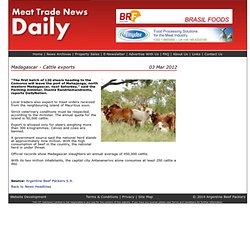
Local traders also expect to meet orders received from the neighbouring island of Mauritius soon. Strict veterinary conditions must be respected, according to the minister. The annual quota for the island is 50,000 cattle. Export is allowed only for steers weighing more than 300 kilogrammes. Calves and cows are banned. A government source said the national herd stands at approximately nine million. Official records show Madagascar slaughters an annual average of 450,000 cattle.
With its two million inhabitants, the capital city Antananarivo alone consumes at least 250 cattle a day. Source: Argentine Beef Packers S.A. Back to News Headlines. Fièvre de la vallée du Rift. CNEV - Accueil. Epidemiology of chikungunya infection on Reunion Island, Mayotte, and neighboring countries 10.1016/j.medmal.2011.12.002 : Médecine et Maladies Infectieuses. General review Épidémiologie du chikungunya à la Réunion, Mayotte et dans les pays avoisinants a Cellule de l’Institut de veille sanitaire en région (Cire Océan Indien, InVS), 2 bis, avenue G.
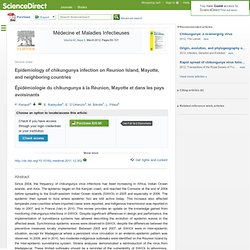
-Brassens, CS 60050, 97408 Saint-Denis cedex 9, Reunionb Service de lutte antivectorielle de l’Agence de Santé océan Indien (Ars OI), délégation Réunion, 97400 Saint-Denis, Reunion Received 22 December 2009, Revised 10 February 2011, Accepted 14 December 2011, Available online 25 January 2012 Choose an option to locate/access this article: Check if you have access through your login credentials or your institution Check access Show more Show less Get rights and content. Mary Ann Liebert, Inc. - Vector-Borne and Zoonotic Diseases - 11(4):395.
RVF_2001_ SHAIF_environment - socioeco factors. To cite this article:Shaif Abdo-Salem, Annelise Tran, Vladimir Grosbois, Guillaume Gerbier, Mansoor Al-Qadasi, Khalid Saeed, Eric Etter, Etienne Thiry, François Roger, and Véronique Chevalier.
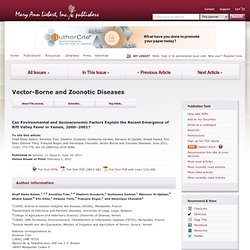
Vector-Borne and Zoonotic Diseases. June 2011, 11(6): 773-779. doi:10.1089/vbz.2010.0084. Published in Volume: 11 Issue 6: June 16, 2011 Online Ahead of Print: February 1, 2011 Author information Shaif Abdo-Salem,1,2,3 Annelise Tran,1,4 Vladimir Grosbois,1 Guillaume Gerbier,1 Mansoor Al-Qadasi,5 Khalid Saeed,5 Eric Etter,1 Etienne Thiry,2 François Roger,1 and Véronique Chevalier1. MEtras_RVF_model. Viruses and antiviral immunity in Drosophila Jie Xu, Sara Cherry CrossRef A brief review of spatial analysis concepts and tools used for mapping, containment and risk modelling of infectious diseases and other illnesses GRAZIELLA CAPRARELLI, STEPHANIE FLETCHER CrossRef A statistical model of Rift Valley fever activity in Egypt John M.

Modeling the Spatial Spread of Rift Valley Fever in Egypt Daozhou Gao, Chris Cosner, Robert Stephen Cantrell, John C. A systematic review of mathematical models of mosquito-borne pathogen transmission: 1970-2010 R. Breaking the chain: Rift Valley fever virus control via livestock vaccination. Rift Valley Fever Workshop - January 27-29, 2009 - Dokki, Giza, Cairo, Egypt. Presentations Day One Day Two Day Three Hanafi A.
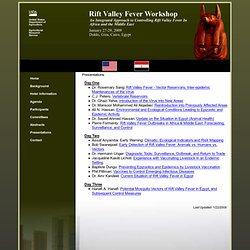
Hanafi: Potential Mosquito Vectors of Rift Valley Fever in Egypt, and Subsequent Control Measures. Colloque madagascar 2011.
Vecteur. Télédétection. Études d'impact. Politiques publiques. Situation géographique. Vaccin. Participatory epidemiology: Approaches, methods, experiences. Abstract Participatory epidemiology (PE) is an evolving branch of veterinary epidemiology which uses a combination of practitioner communication skills and participatory methods to improve the involvement of animal keepers in the analysis of animal disease problems, and the design, implementation and evaluation of disease control programmes and policies.
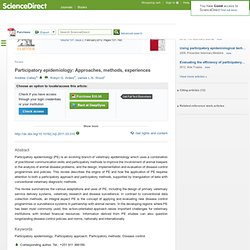
This review describes the origins of PE and how the application of PE requires attention to both a participatory approach and participatory methods, supported by triangulation of data with conventional veterinary diagnostic methods. The review summarizes the various adaptations and uses of PE, including the design of primary veterinary service delivery systems, veterinary research and disease surveillance. In contrast to conventional data collection methods, an integral aspect PE is the concept of applying and evaluating new disease control programmes or surveillance systems in partnership with animal owners. Keywords.